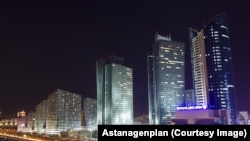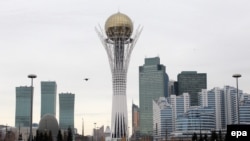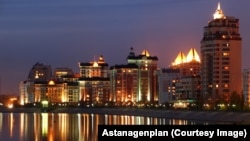
Something new is coming to Central Asia, and something new is coming from Central Asia, and it’s all due to the imminent opening of a long-closed ancient trade route.
The reemergence of Iran into global trade has many countries pondering the potential benefits and detriments.
For Central Asia, one benefit is obvious -- a third trade route. For many centuries, caravans crossed through Iran and Central Asian territory, but it has been well over 100 years now since trade between, or across, Iran and Central Asia flowed freely.
How significant could Iran be as a trade route for Central Asia? How quickly could the new route make a difference to the economies of the Central Asian states, all of which are currently in crisis? What are the limits to Central Asia’s cooperation with Iran?
RFE/RL’s Turkmen Service, known locally as Azatlyk, assembled a majlis, a panel discussion, to look at these questions and other matters.
Azatlyk Director Muhammad Tahir moderated the roundtable. Participating from Wales was Hossein Aryan, a former deputy director of RFE/RL’s Persian Service, known as Radio Farda, and currently an independent analyst on Iran. From Glasgow University, senior lecturer on Central Asia Dr. Luca Anceschi joined the discussion. And I, of course, was raring to get into this topic myself.
After the collapse of the Soviet Union, in late 1991, the five Central Asian states had one export route, through Russia. For approximately the next 15 years, that was the only major trade route. There was some mercantile activity across the Caspian and Turkmenistan, which borders Iran (remember that, it’s important), and gas was exported to Iran via a pipeline built with funds from the Islamic republic.
China entered the picture visibly about 10 years ago, building oil and gas pipelines and making improvements to roads and railways to facilitate trade, albeit mainly raw materials and energy resources coming from Central Asia to China.
Still, Central Asia does import a significant amount of goods from China and trade with the Middle Kingdom has grown. More importantly, Central Asia gained a trade route leading east, a second major trade route.
But the economies of Russia and China are experiencing difficulties, so now would seem an incredibly fortuitous time to see a third trade route open up, this time south through Iran.
Anceschi said, “I think that we will see that having this reentry of the Islamic republic onto the world stage does actually favor the Central Asian states, giving it easier access to global markets, to the open sea, to the [Persian] Gulf.”
Some people, including me, have pointed out in recent months that Iran would be a fantastic transit country for potential Central Asian oil and gas exports to Europe. That was not disputed.
But Aryan said it would not be something Tehran would be ready to agree to just yet.
“I think first and foremost [Iran] will be thinking of its own interests. Iran in 2011 was exporting something like 2.5 million barrels of oil per day and then after sanctions it decreased to something around about 1 million. So now, more than anything else, as Iranian officials have stressed, they want to increase the output,” Aryan explained.
And Aryan added, “It will take quite awhile and Iran must do a lot to improve its infrastructure in order to become a corridor for trade, or the transfer of oil [or gas] from Central Asian countries.”
But in terms of other trade, Anceschi said, “Iran can be a real game changer for infrastructure -- railways, freeways, roadways...that could actually change a lot in terms of the connectivity of Central Asia with the rest of the world.”
And Anceschi, speaking about energy resources, noted Central Asia also stands to benefit further as a transit region.
“I think that China is probably the most interesting case because the way in which the demand of China has been articulated was always done in order not to have too much dependency on a single source, and adding Iran -- now able to produce more, to sell more -- is actually something from which China could benefit a lot.”
Indeed, linking China and Iran through Central Asia is something of a re-creation of the ancient Silk Route.
But the panelists agreed that even this level of integration would probably take the better part of a decade to realize, perhaps not such a great length of time given the long histories of the peoples of this region but too long to offset the current economic difficulties Central Asia is facing.
The panel also looked at the potential risks of a new relationship with Iran. Aryan pointed out the Islamic republic has a history of trying to extend its influence into other countries, such as Lebanon, Syria, Yemen, and Iraq. Aryan said that with billions of dollars of its funds being unfrozen by the United States and the promise of revenues from oil and gas sales, even at current low prices, “that would probably provide Iran with the money to pursue its foreign policy aggressively in the region.”
But Anceschi explained, “If there is one thing which I don’t think the Central Asian leaders [will] change that much, it's how they relate to foreign influence.” He added, “I think that Central Asia will be very careful not to get too close to Iran, but also not to become too distant from Iran, because I think that in terms of economic, beyond energy, the benefits could be quite substantial.”
The panel discussed the possible losers if an Iranian trade route opens. Russia certainly will lose some transit fees from Central Asian exports being redirected through Iran. Azerbaijan is also a potential loser since the trans-Caspian shipping trade is still in its early stages and could quickly be made obsolete by more efficient export land routes through Iran.
A guaranteed winner is Turkmenistan, which would become Central Asia’s gateway to Iran and Iran’s to Central Asia. Anceschi suggested Kazakhstan also stands to gain. There is already a Kazakhstan-Turkmenistan-Iran railway and this could be expanded.
The discussion went deeper into these topics and explored other areas of the impending new trade relationship between Iran and Central Asia.
An audio recording of the roundtable can be heard here:










